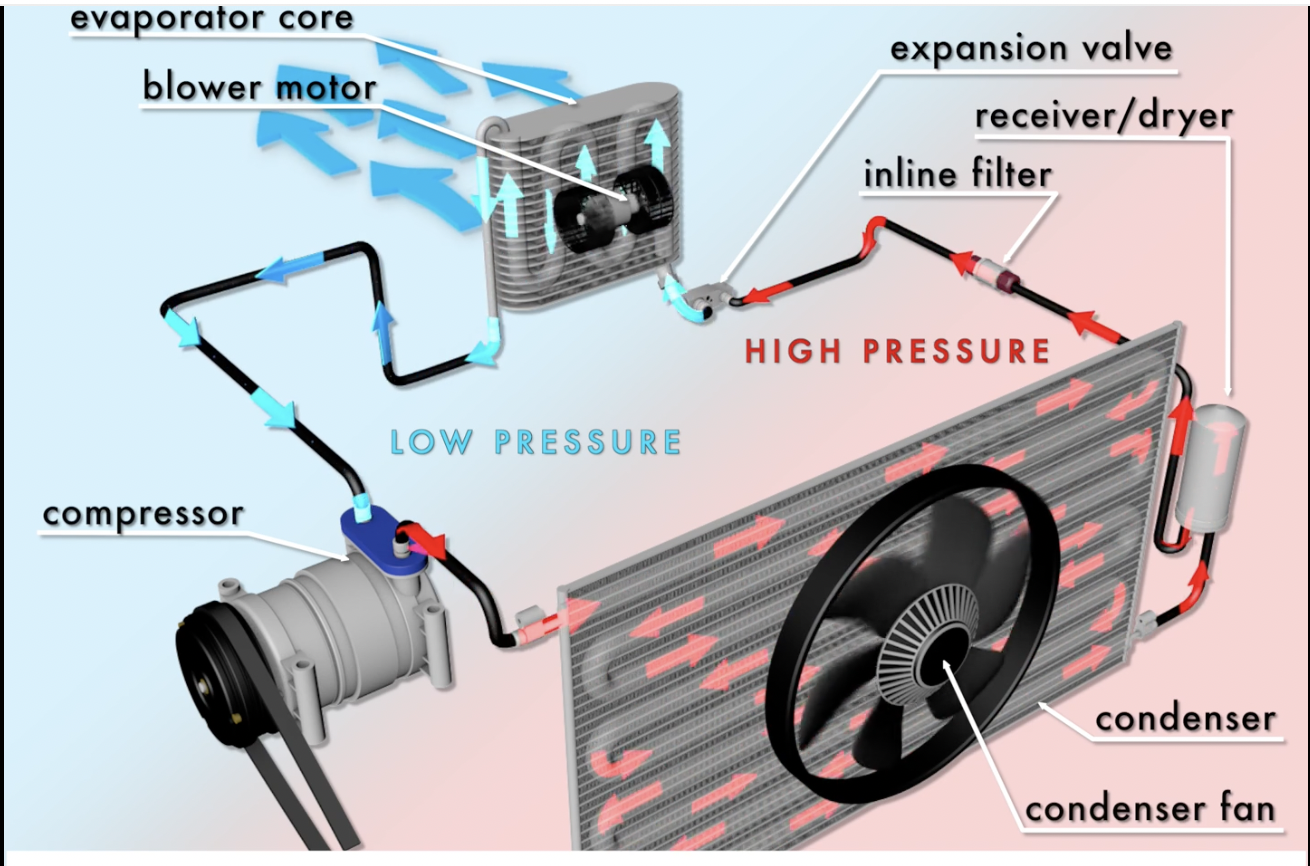

For most car owners, the A/C system is a mystery, you press a button, and are met with a refreshing blast of cold air. But what happens behind the scenes is actually fairly complex, and very interesting. We already went over how your vehicle’s heating system works in our last blog post, but as the months get warmer your vehicle’s A/C system becomes that much more important. Did you know a vehicle’s air conditioning system does not create cold air? It takes the heat and moisture out of the air that is already in your car, giving you cooler air. Understanding how the components work can help to identify any repairs that may be needed down the road.
Air conditioning in vehicles has been around a lot longer than you may think! “Packard invented automotive a/c back in 1939, and in 1940 was the first car company to offer factory-installed air conditioning. Of course, this early system didn’t have a thermostat, but it was better than not having anything at all. The idea caught on, though, and by 1969, more than half of all new cars were sold with air conditioning built-in.”
Air conditioning has worked mainly the same way for its entire existence. There are three main parts to the system: the compressor, condenser, and evaporator, plus a few other parts to keep the system running smoothly. Let’s take a look at each!
The High-Pressure Side
All automotive air conditioning systems have a high-pressure side (in red in the image above) and a low-pressure side (in blue in the image above). We’ll start with the high-pressure side as it leads from the engine to the passenger compartment:
Compressor
Refrigerant resides in the a/c system. When the refrigerant is drawn into the compressor, it is in a low-pressure gaseous form. The compressor is a pump that, as you might guess, compresses the refrigerant into a high-pressure state. This pressure forces the refrigerant out of the compressor and through hoses, which carry it to the condenser next.
Condensor
The condenser is similar to a small radiator. It puts the refrigerant in contact with fresh air from the outside of the vehicle. The purpose of this is so the air absorbs all of the heat from it. The process of pressurizing the gas and moving it to the condenser creates heat, but air flowing around the tubes of the condenser cools the refrigerant down until it forms a liquid again.
Receiver Dryer/Accumulator
As it moves out of the condenser, the liquid moves into the receiver dryer/accumulator. This part contains desiccants, small particles that attract water. You’ve most likely seen packets of desiccants in shoeboxes, where they do the same thing: attract water from the air to keep new shoes fresh. (They’re usually labeled “Do not eat.”) In the receiver dryer, these particles remove any water that has entered the system.
The Low-pressure Side
Next, the liquid travels to the expansion valve. Here, the system changes from the high-pressure side to the low-pressure side. If you were to touch this part of the system, you’d feel it change from hot to cold!
Expansion Valve
The liquid refrigerant flows from the receiver dryer through the expansion valve, where it is allowed to expand. This expansion reduces the pressure on the refrigerant, so it can move into the evaporator.
Evaporator
While all the other parts of the system are located in the engine compartment, the evaporator is inside the cabin, usually above the footwell on the passenger side. Refrigerant enters the evaporator as a cold, low-pressure liquid. The heat in the cabin of the car is enough to make the refrigerant boil and become a gas again. The gas moves out of the evaporator, taking the heat with it.
*The evaporator also takes the humidity out of the air in the car, which helps you feel cool. Water in the air condenses on the evaporator, along with dirt, pollen, and anything else floating around in the cabin. When you stop the car and see water dripping underneath, it’s most likely the water from the a/c evaporator!*
Blower Motor
A fan blowing over the outside of the evaporator blows cool air into the passenger compartment, cooling you down! The refrigerant in gas form then enters the compressor, where it is pressurized and the whole process starts all over again.
During these months leading up to summer, it is always a good idea to have your A/C recharged. This is the process of adding fresh refrigerant into the system. If the refrigerant is a bit low, it can be topped off, but if it’s really low, whatever refrigerant is still in the system needs to be drained out and replaced. This process of clearing out the system and adding new fluid is called recharging.
If you’ve lost some refrigerant, or your a/c isn’t working properly, it is a good idea to have our certified technicians take a look at it as the warmer weather is approaching. We will check over each part in the a/c system for any obvious leaks. If your a/c system does have a leak, it is important to bring your vehicle down to Luke’s Auto Service in Essex County, New Jersey so we can get that fixed as soon as possible as refrigerant leaking can harm the atmosphere.
References:
Image:
